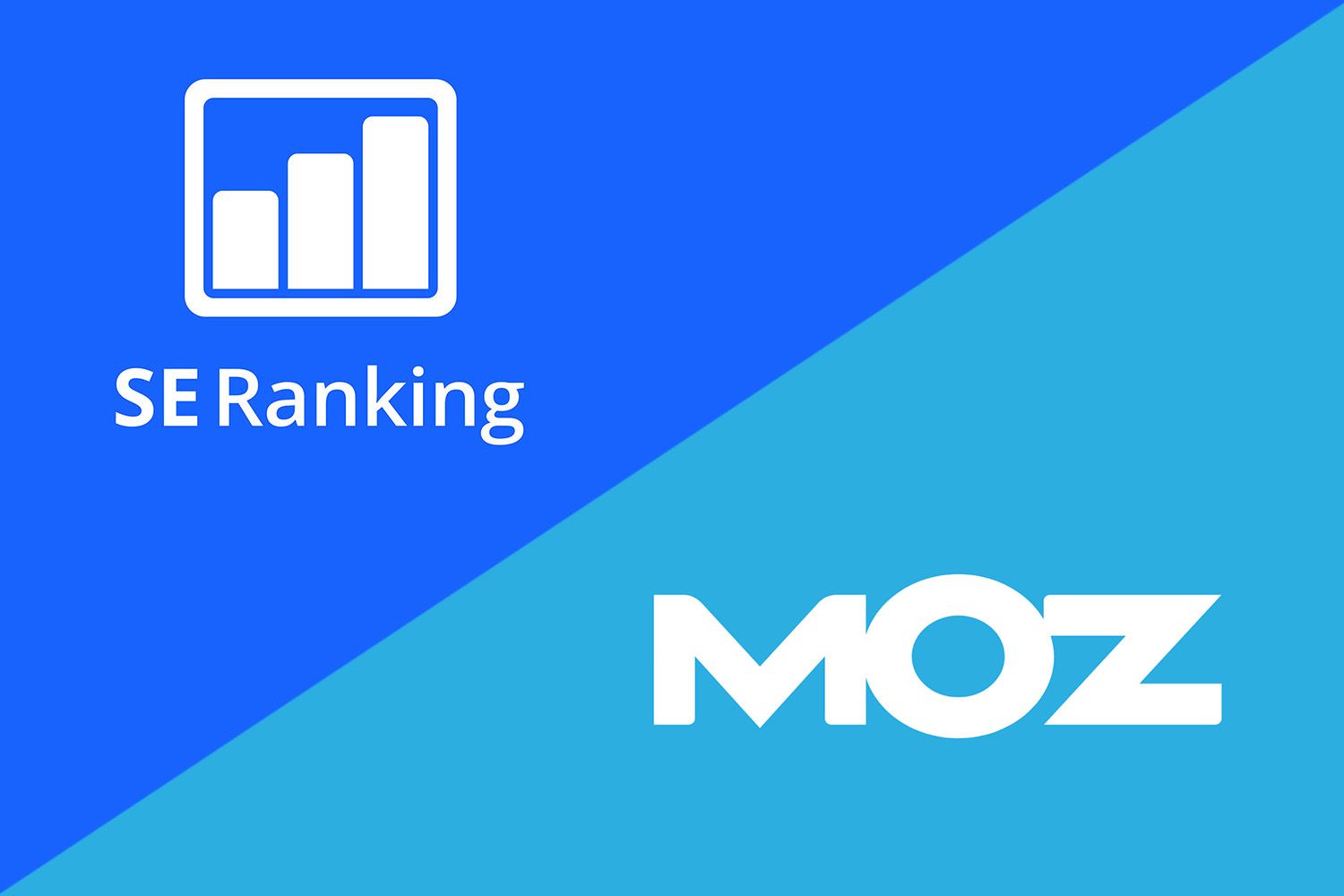
Are you searching for a complete SEO toolkit to skyrocket your Google ranking? Perhaps you’re considering SE Ranking or Moz. We’re talking about two powerful SEO tools packed with features for rank tracking, keyword research, and content marketing.
SE Ranking is known for its intuitive interface and a heap of easy-to-access features. This service is one of our favorite and the closest rival to Semrush. By many, including us, Semrush is the #1 option. But what about Moz? How does it compare?
Moz or Moz Pro is a professional SEO tool that aids link-building, competitor analysis, and keyword generation. In our SE Ranking vs Moz duel, we’ll compare these two directly to see which tool is better for you. We’ll do this through several exhaustive tests.
Not only will we analyze their features but also ease of use, price, customer support, and free plans. At the end of the day, we’ll tell you which one to pick and why. Now, this is a long read, so don’t go anywhere. We promise to be concise and painfully honest!
SE Ranking vs Moz: Quick Conclusion
Not looking to read the entire comparison? Here’s a quick verdict – SE Ranking wins against Moz! Below, we list both services’ most notable advantages:
SE Ranking Is Best for:
- Competition research
- Keyword analysis with search intent info
- Local SEO
- Generous keyword tracking limits
- On-page and site audits
- Competitive pricing (from $52/mo)
- Ease of use and intuitiveness
Moz Is Best for:
- Backlink analysis (7 trillion backlinks)
- Capable free SEO tools
- Keyword clustering
- Toxic backlink detection
Moz vs SE Ranking Features Comparison
As always, we’ll start this duel by discussing their features. Moz and SE Ranking are extremely well-equipped and you’ll surely find something to cover your needs. However, one service will win, and to find out which, keep reading.
Domain Research
Domain research is a highlight of both services. It functions simply. You provide the domain name – yours or your competitor’s and Moz and SE Ranking provide you with insightful information such as:
- Domain authority
- Referring domains
- Ranking keywords
- Ranking distribution, and so on.
We like how SE Ranking looks, as its information is divulged more comprehensively. Moz’s “raw” look relies primarily on text rather than graphs and can be a bit outdated at first. However, we can’t say they don’t provide enough information about each domain.
In SE Ranking, you’ll find info related to paid and organic keywords, keyword search intent, CPC, and so on. Moz, for example, offers the Brand Authority metric, which measures how strong the brand is. Logically, higher-ranking sites have a higher score and vice versa.
Traffic Research
Under the domain research menu, you’ll find various traffic research options in SE Ranking. Users can examine organic and paid traffic of their sites or do so for competitor domains. This will give an insight into ranking keywords, total traffic, and ranking changes.
In the Domain Overview menu, SE Ranking shows you its traffic forecast. It’s an interesting metric that signals the potential of the domain to attract traffic. Moz lacks this metric but offers basic traffic research to get more info about organic traffic.

We dislike its poor PPC research capabilities which were always Moz’s weakness. On the other hand, Moz uses Google Analytics to provide you with traffic information, so it’s pretty accurate. We can say the same about SE Ranking.
Both tools are accurate for more popular domains, while domains with less than 5K visitors a month often get overlooked. This is also the case with Semrush whose traffic estimations for smaller domains can be so-so.
Competition Research
In SE Ranking, we like the option to compare your domain to competitors. You’ll then see a graph of keyword combinations, some of which are unique to each site and some that overlap. SE Ranking’s Competitor Comparison feature offers something more.
Here, you can see common and missing keywords, along with the number of organic keywords and traffic of your competitors. This direct comparison gives plenty of information about potential improvements that you can apply to rival them.
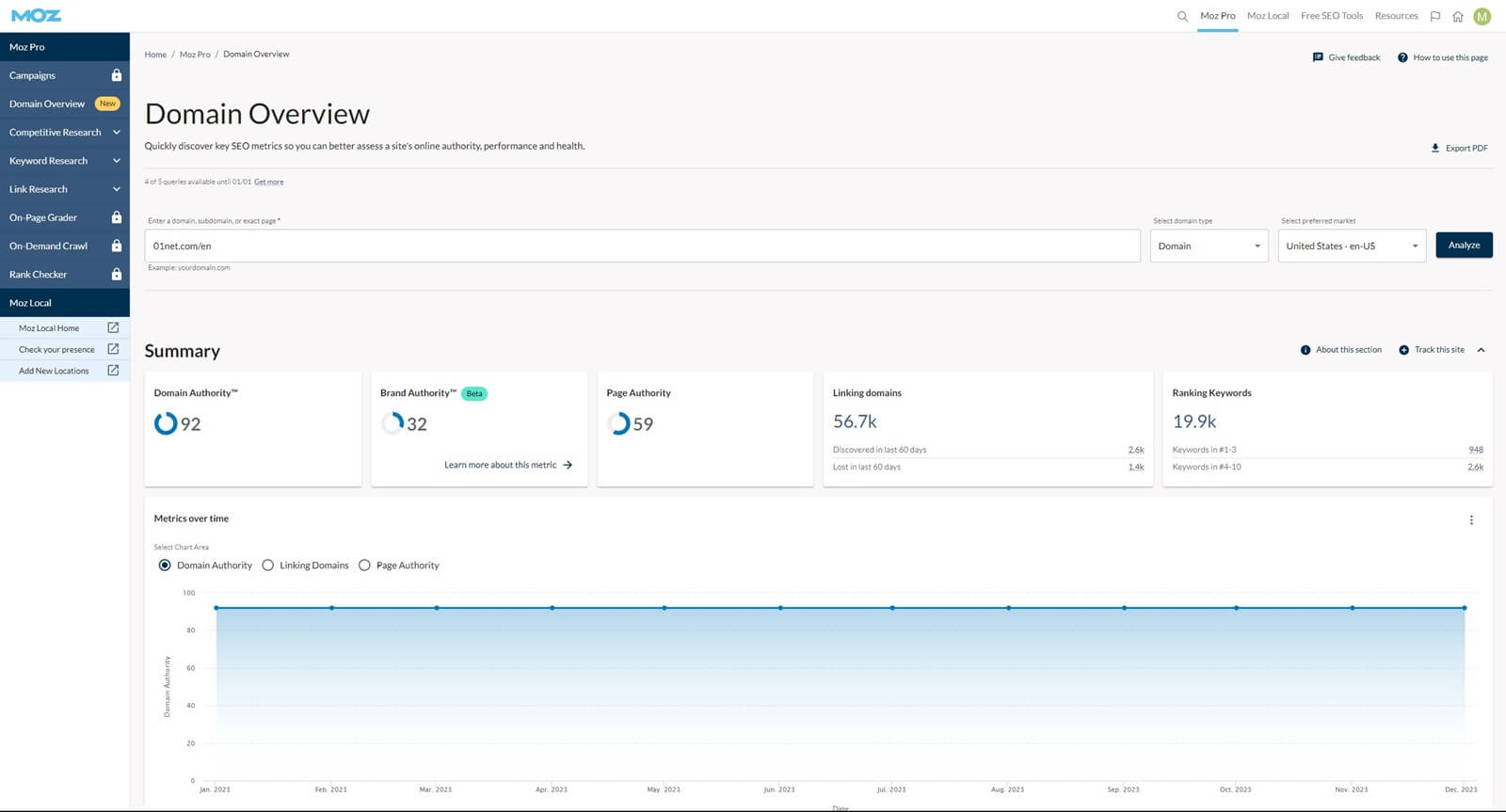
We also shouldn’t forget about the Competitive Research overview. This feature analyzes a competitor’s website and displays its keywords, organic traffic, domain trust, page trust, and traffic distribution. Also, SE Ranking displays the site’s SERP features – something we value.
We used this feature to see our competitors’ top ads, knowledge graphs, images, featured snippets, and so on. Moz has an option titled True Competitor. It detects your true competitors based on your website’s domain. However, in many cases, it’s inaccurate.
For example, when we typed our domain – 01net – according to Moz, our #1 competitor was NETFLIX. Really?! We then found a few true competitors at the third, tenth, and other spots. SE Ranking has this function under its Competitive Research Overview menu.
Just scroll down and you’ll find that its organic competitor results are more accurate. It lists a few of them but we can assure you they ARE our direct competitors. We won’t mention them here for obvious reasons.
Domain Authority Score
Domain authority is vital for ranking higher in SERPs. To obtain it, you must focus on building enough quality backlinks through impeccable content and hard work. SE Ranking calls this Domain Trust and it’s based on the backlink profile, to simplify things.
SE Ranking will see how many backlinks you have and if you have a lot of quality referring domains, your domain trust will be higher. A similar thing is with its Page Trust score, which signals the page’s potential to appear in the search results based on the same parameters.
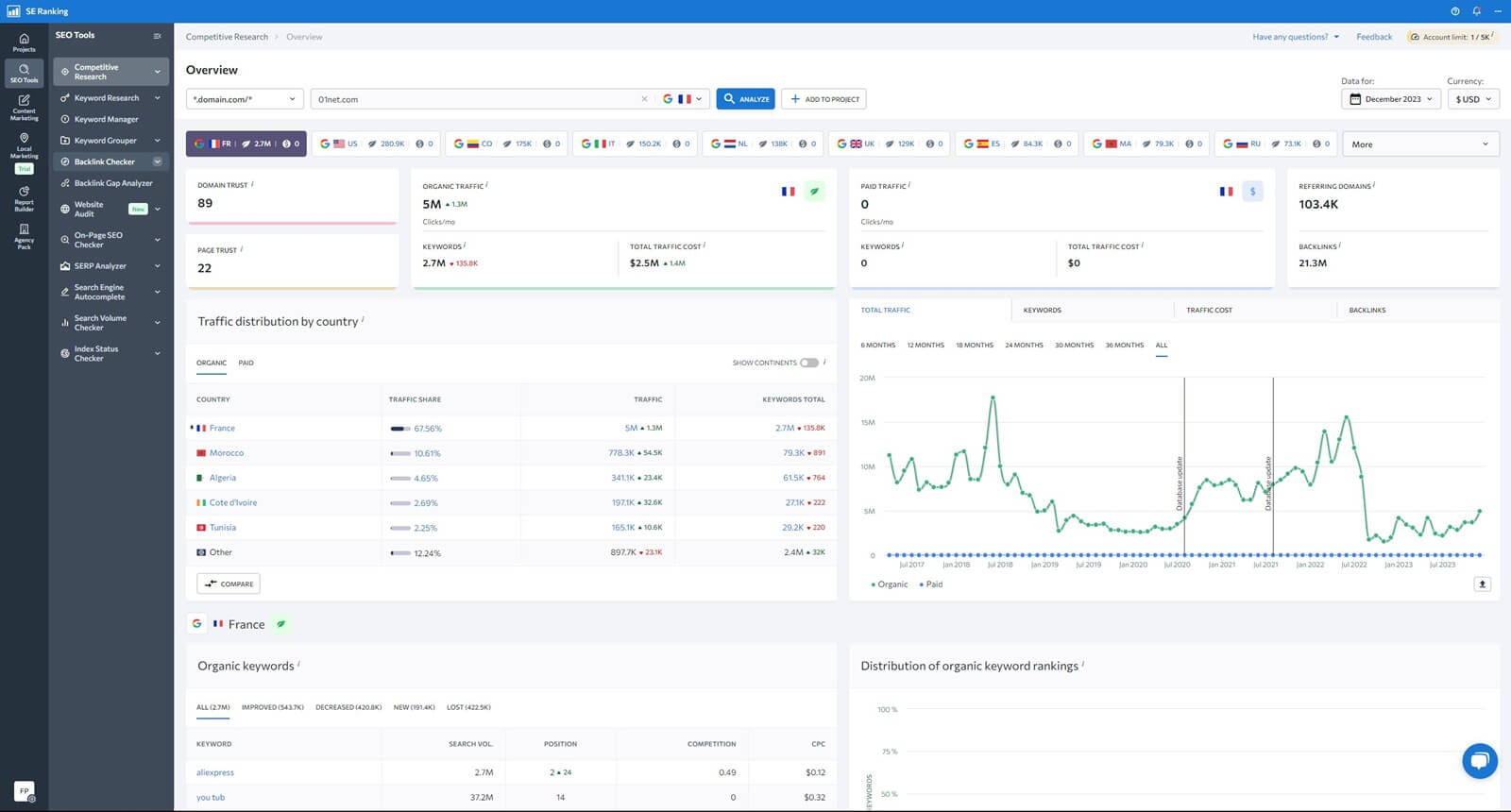
Moz’s Domain Authority score is calculated differently, so it’s often lower than SE Ranking’s calculation. It uses things like backlink numbers, linking root domains, and various machine learning calculations to “spew” the most accurate score.
To be honest, we think Moz is a bit more precise, and sometimes, the striking difference between Moz and SE Ranking hits you right in the eye. For one website, which isn’t the most popular, Moz gave us 26, while SE Ranking came up with a score of 33.
However, page authority scores were the opposite – 8 in SE Ranking and 42 in Moz. We deem Semrush more accurate than both when analyzing domain authority, and we do so for Ahrefs, which is often a benchmark for this parameter.
In general, it’s hard to pick between Moz and SE Ranking in this category. Domain research is impeccable in both but we give advantage to SE Ranking for superior PPC and paid traffic research.
Keyword Research
Domain and keyword research are closely related. Domain research often shows you some keyword-related data but keyword analysis is much more complex. In this Moz and SE Ranking duel, we liked both but we preferred using SE Ranking a tad more.
First of all, basic metrics are here in both, so don’t get things twisted. By that, we mean:
- Difficulty
- Volume
- Keyword Suggestions
Again, we prefer SE Ranking’s keyword overview due to how intuitive it is. Everything is laid out beautifully and all vital bits of data are easy to notice. No wonder it’s one of our favorite keyword research tools in 2025. SE Ranking also includes Search Intent.
You won’t find this metric in Moz. Thankfully, Moz and SE Ranking show SERP features of each keyword, with organic results from some of the highest-ranking sites. Keyword suggestions are numerous in both cases but again, SE Ranking comes up with more.
Keyword Suggestions
We’re talking about suggestions like questions, similar keywords, closely/broadly related topics, and so forth. In SE Ranking, we prefer the “low search volume” option, which gives you more specific keywords that are easier to rank for in SERPs.
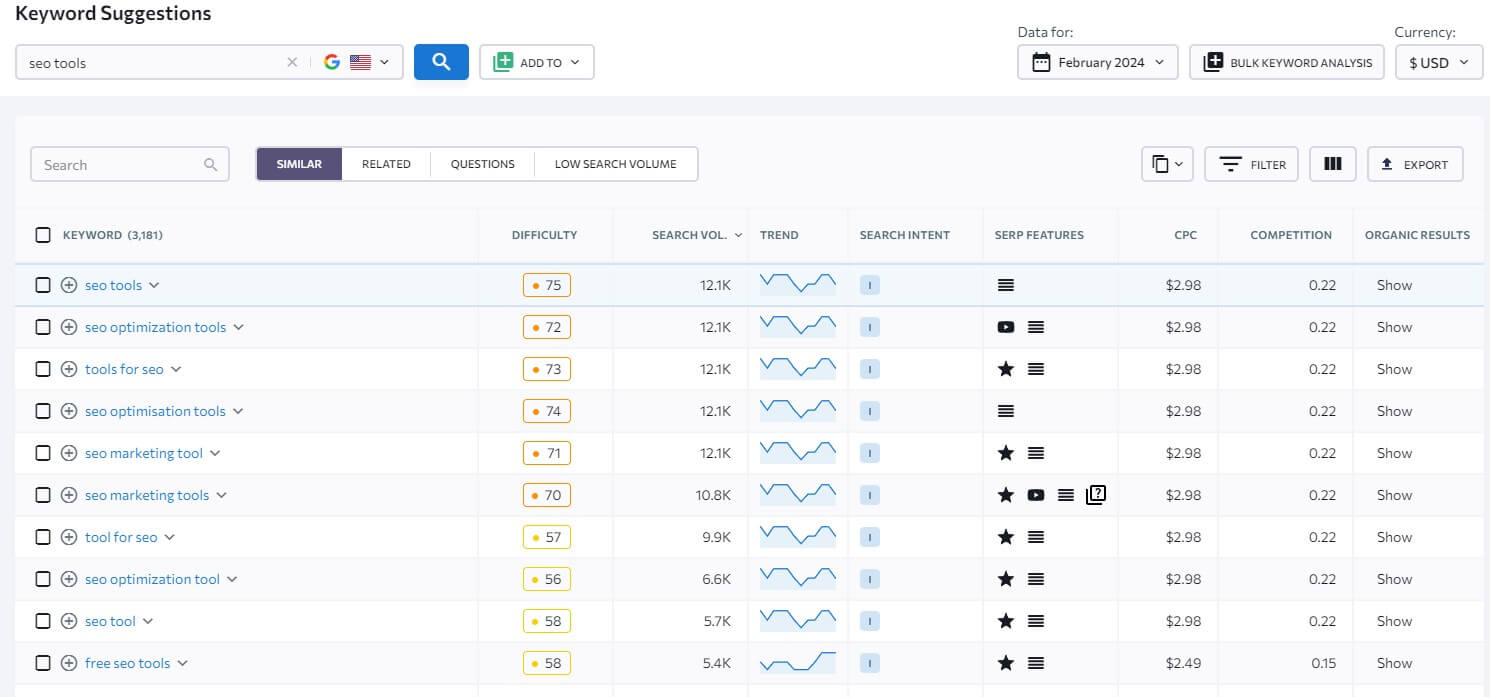
These are usually long-tail keywords with 3+ words in the key phrase. Moz allows you to filter suggestions according to lexical similarity, which broadens or narrows the search. Both tools display volumes, difficulty, and other parameters with suggestions.
Keyword Search Intent
Moz, like Ahrefs, lacks the keyword search intent metric. We deem it important because it shows the intent behind users’ search for the key phrase. It can be navigational, transactional, commercial, or informational.
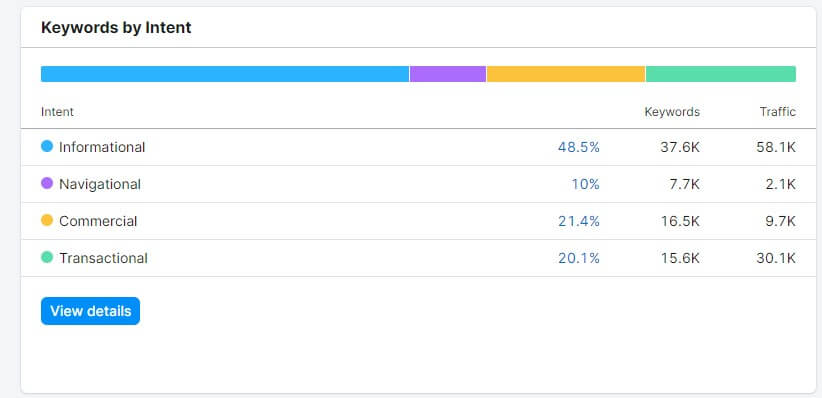
In our opinion, understanding search intent is crucial to understanding your audience. For example, if you want to make more conversions, you’ll focus on including commercial keywords, while informational keywords should be used for blog posts.
SE Ranking’s search intent works like Semrush’s equivalent and in this regard, the service is advantageous in this SE Ranking vs Moz duel.
Priority
Moz, however, has a parameter called Priority whose score goes from 0 to 100. It’s calculated based on other metrics like organic CTR, difficulty, and volume. The higher the score, the better the chances of hitting the “sweet spot” between volume and difficulty.
If the keyword has plenty of volume, it’s usually accompanied by higher difficulty. However, some keywords have a good volume-to-difficulty ratio, which is what the Priority metric represents. It’s an interesting feature that SE Ranking lacks.
Ads History
On the other hand, SE Ranking’s impeccable advertising research is here. The Ads History tools help you discover profitable keywords and their CPC, along with the most popular ads for the given keyword. You’ll see the highest-ranking domains and their traffic cost.
Additionally, SE Ranking displays ads history per month/year, with exact ads from your rivals. You’ll see how much traffic their pages received from the date of publishing, which helps you gain better insight into the profitability of the keyword in question.
Keyword Manager & Clustering
In this Moz vs SE Ranking comparison, the latter includes a handy feature called Keyword Manager. It lets you create lists of keywords and monitor their ranking, difficulty, volume, and other parameters. There’s also the Keyword Grouper tool in SE Ranking.
This is your keyword clustering tool, where you can group keywords according to their similarity based on the search queries. SE Ranking allows you to select the grouping accuracy and method, which helps personalize the experience.
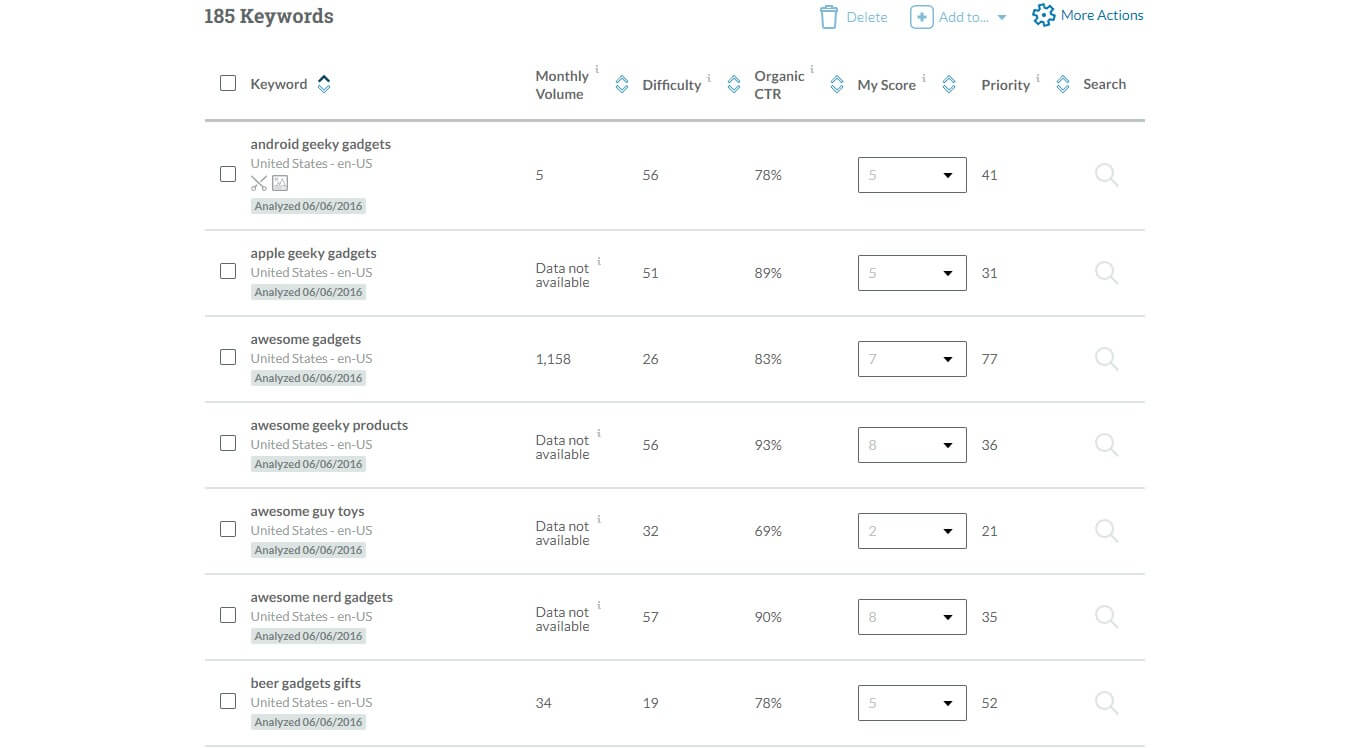
Moz has this Keyword Lists tool, which does the same. However, we like it a bit better, as it’s not paid additionally like in SE Ranking, where the cost per query is $0.004. Moz includes this feature in the Moz Pro Medium plan, though, but it’s pretty handy.
You can import, export, or create lists and get SERPs with their volume, CTR, priority, and monthly volume. According to the given keyword, Moz comes up with SERPs that you can include in your pages to properly cover the topic and gain higher topical authority.
Keyword Gap
Keyword gap detection is another mutual function in this SE Ranking vs Moz duel. It’s conversely important for competitor analysis, as it lets you discover keywords your competitors rank for but you don’t. However, this feature in SE Ranking is harder to find.
It’s under Competitor Comparison, where you’ll discover missing keywords that your rivals use but you don’t. Moz calls this feature a Keyword Gap.
Here, you enter your domain name and then provide three more domains to start the comparison.
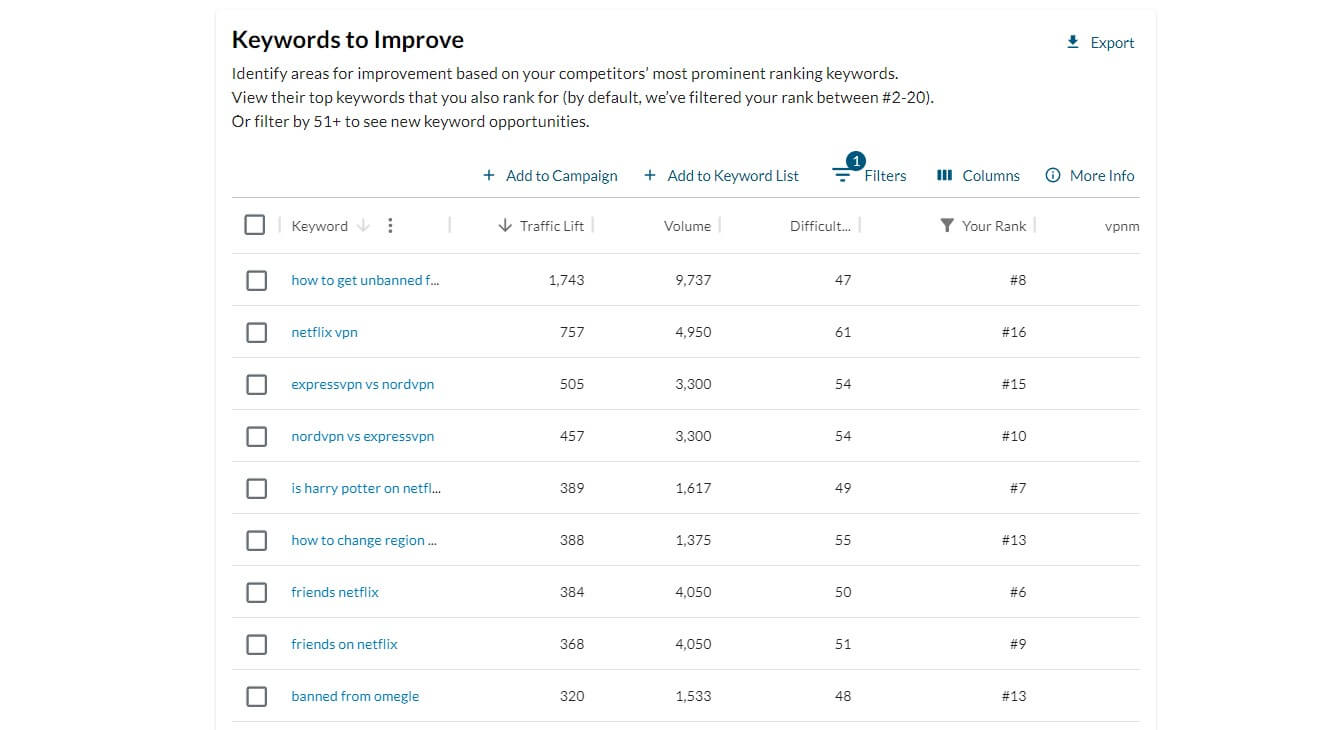
Moz then shows you shared keywords and below is the table with thousands of ranking keywords of your competitors that you can use. Again, we think Moz isn’t very intuitive here because it doesn’t explicitly show missing keywords.
You need to instead click on the competitor and see its ranking keywords. Then, according to their volumes and difficulty, decide whether you want to push your luck. Semrush does this MUCH better and is excellent at providing clear data for keyword gap detection.
Even better, Semrush finds weak and strong keywords of your competitors that you can capitalize on. Not to mention its option to find lost keywords that your competitors aren’t ranking for anymore, which is another weakness to exploit.
Rank Tracking
Whether you pick Moz or SE Ranking, tracking keyword rankings will be simple. Both services will update their ranking data daily, allowing you to see your status among the competition. We love their email alerts as well, which come as the icing on the cake.
SE Ranking will inform you weekly about your rank changes. If it’s going up, you’re doing great. If not, evaluate your SEO strategy and apply improvements. Historical data is available in both, so you can track your performance across the specific period for added insight.
Link Building/Backlink Analysis
Analyzing and building your backlink profile is one of the best things you can do for your site. But to do that, you need high-quality and authoritative content that someone can link to. With Moz and SE Ranking, you’ll gain more information about your backlink progress.
However, it’s worth keeping in mind that Moz’s backlink database is larger. It offers 7 trillion, while SE Ranking is at 3 trillion. In our tests, SE Ranking constantly detected fewer referring domains and we attribute it to its smaller number of backlinks.
On the other hand, both services display plenty of useful backlink information. They include:
- Referring domains
- Domain authority/trust
- Backlinks (new and lost)
- Backlink anchors
- Top referring domain anchors
- Follow/nofollow links, and so on…
We like SE Ranking’s Backlink Checker a tad more compared to Moz’s Link Research tool. It displays a bit more data, such as toxic and broken backlinks. This doesn’t mean you can’t detect them with Moz. It’s just that SE Ranking shows this information at the forefront.
SE Ranking offers the Backlink Monitor tool as well, where you can disavow the links you want Google to ignore. Moz, for example, lacks the Disavow tool, so you have to use GSC. SE Ranking, however, also relies on GSC for its Backlink Monitor tool and a few others.
That’s still our complaint compared to Semrush which fetches almost all of its information from Google Analytics and displays it in the app. Read more about Semrush here.
Toxic Backlinks
Moz offers the Spam Score metric, which shows the quality of your backlink profile. Spam Score shows the percentage of non-toxic, potentially toxic, and toxic backlinks. The lower the number of the latter two is, the lower the spam score.
For our domain, Moz’s spam score was 11%, which is great. Under the graph in this tool, Moz also shows you the most toxic links with a spam score of 100%. You can click on these links and see where they lead but sadly, can’t disavow them directly from Moz.
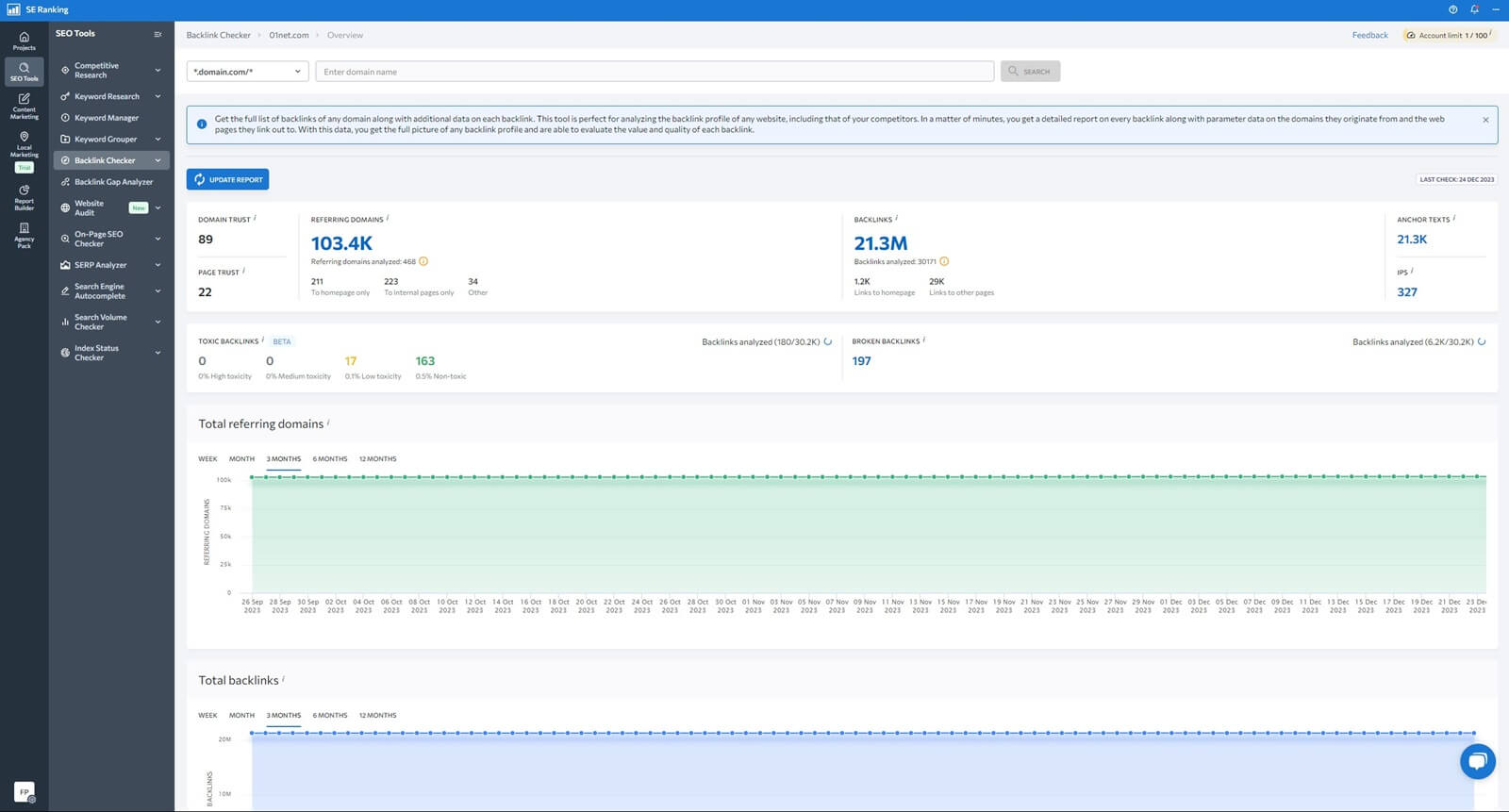
SE Ranking comes with your classic toxicity score. It’s calculated the same way. This time, the service included non-toxic, toxic, medium-toxic, and low-toxic links, making things more accurate. You can select any of these categories and see corresponding links.
Users can also click on the broken backlinks and see the referring domain’s domain/page trust score. In this Moz vs SE Ranking comparison, both are excellent at analyzing backlink toxicity, which, if fixed, can dramatically improve your ranking.
Backlink Gap
Moz comes with the Link Intersect tool, which analyzes backlink gaps. Backlinks gaps help you find the websites that link to your competitors but not your site. Enter your domain address and then add a few competitors to begin the comparison.
Moz will then display a table with all the domains that link to the competitors, allowing you to find backlink opportunities. However, unlike Semrush, it offers no link-building tool where you can contact websites and ask for a guest post or backlink.
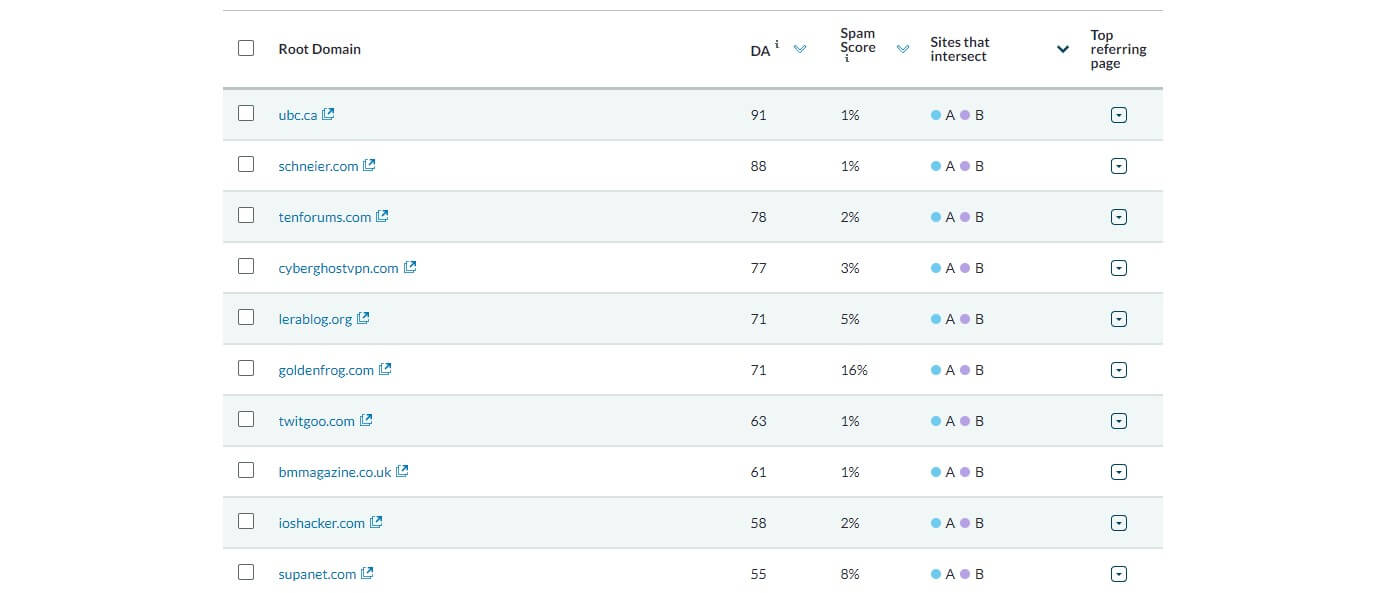
That could be said about SE Ranking. Still, SE Ranking offers the Backlink Gap Analyzer, which works wonderfully. It comes up with a table that displays the referring domains of your competitors, along with the backlinks that you can click on.
SE Ranking and Moz can analyze your domain and compare it to up to 5 competitors, so they’re equal. Semrush can only do 4, for example.
Link Tracking Lists
An interesting feature in Moz allows you to track your link-building progress and is called Link Tracking Lists. This feature lets you create a list where you’ll add a URL for which you plan to build links. Then, you’ll add a few URLs you want to get backlinks from.
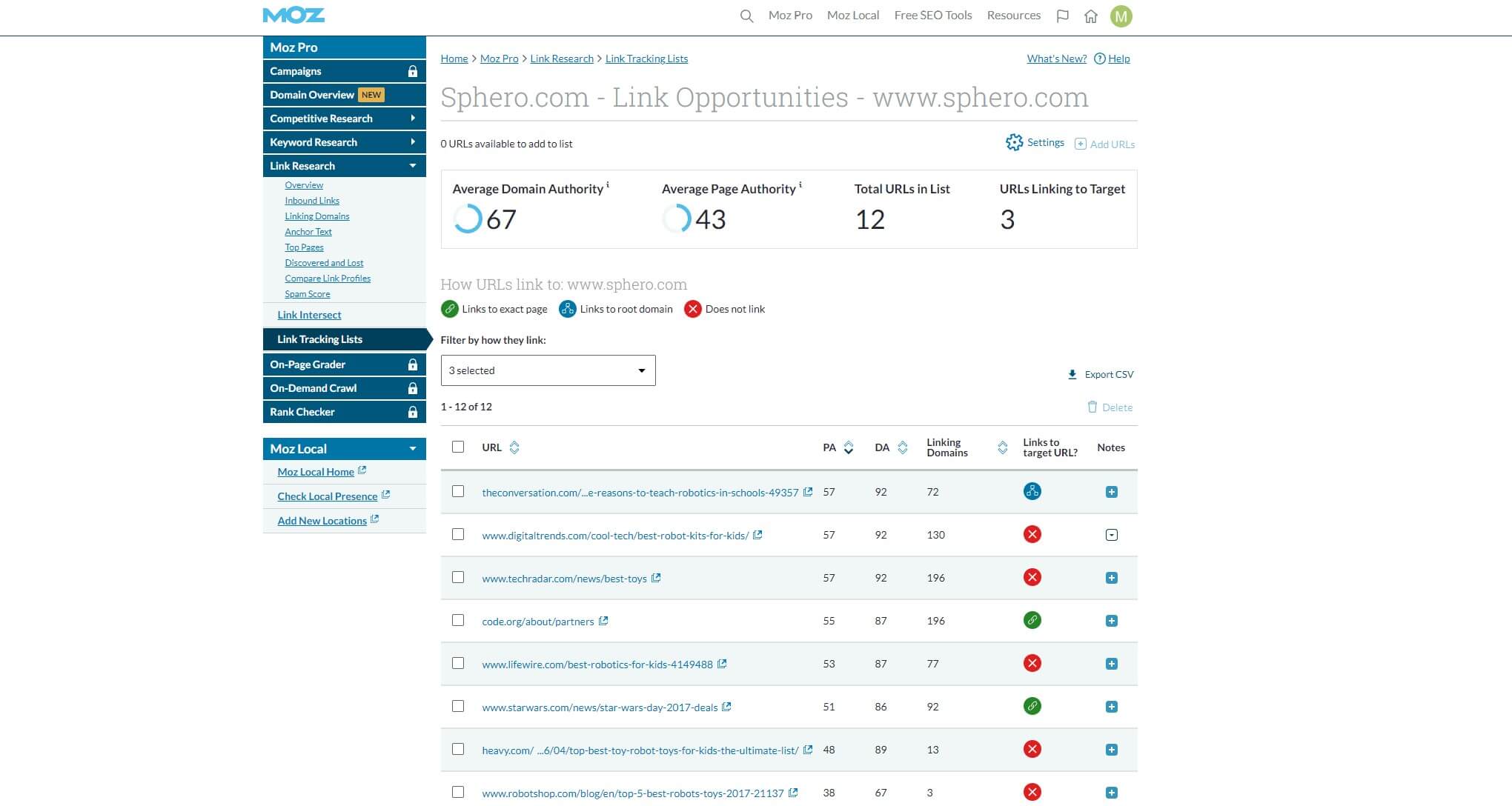
Moz will now enable you to track these URLs and see how and if they link to the target URL you created at the very start. You’ll see if the added URLs link to the target URL’s exact page or root domain, or if they link at all.
You can add notes next to each link on the list, which can help remind you of specific tasks you need to complete to fulfill your link-building goal. In the backlink analysis category, Moz wins because of a larger backlink database and the ability to detect more toxic backlinks and refer domains for greater accuracy.
Site Auditing
Moz and SE Ranking offer site audit functions that we appreciate. SE Ranking, specifically, looks and functions very well. Its crawling speed is impressive, as it goes through the motion promptly and comes out with a health score, top issues, link attributes, and other data.
We love how SE Ranking displays core web vitals that you don’t have to seek on GSC. Moz doesn’t but it functions the same and its On-Demand Crawl tool is impeccable. It’ll display the number of crawled pages and sort the found issues by category.
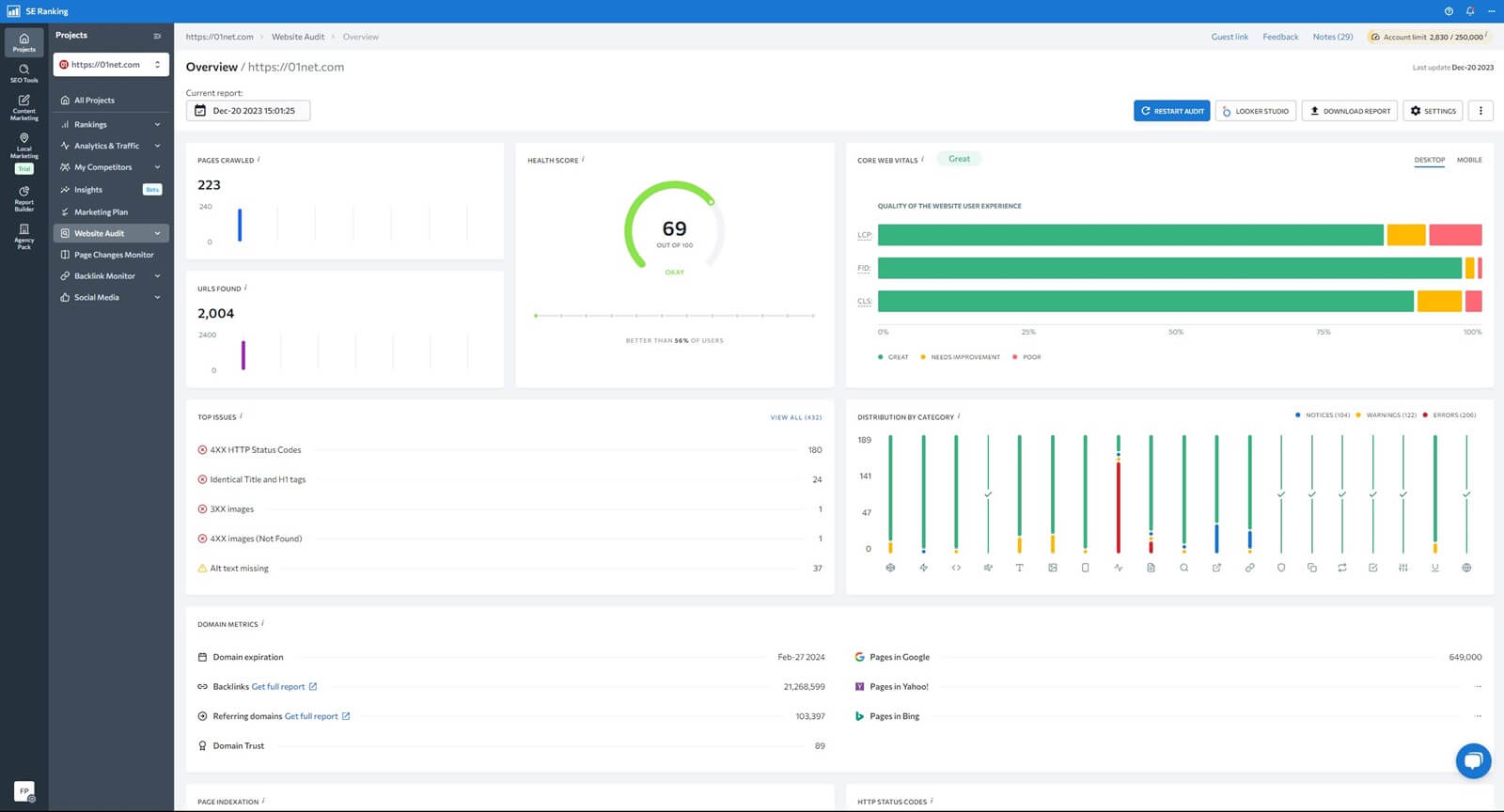
Each issue is explained thoroughly whether you pick Moz or SE Ranking. Additionally, both services will tell you HOW to fix these issues and why they appeared in the first place. For comprehensive site audits, we usually pick Semrush but these two are more than great.
SE Ranking offers the Crawl Comparison tool, where you can compare crawls from different periods. This will show whether you’ve made improvements since the last time, allowing you to track your progress more effectively.
On-Page SEO Audit
We like that both let you analyze each page individually for potential errors and performance issues. This functions like your classic site audit but focuses on an individual page to help you optimize it and improve its health score.
SE Ranking has the On-Page SEO Checker, which works according to your parameters. You’ll need to provide the page link, main keywords, and the desired region. SE Ranking will now display the aforementioned parameters and advise fixes if needed.
Moz has the On-Page Grader tool with a heap of suggestions to help you maximize the page’s potential. It even includes content suggestions and optimization scores, with warnings and errors that should be remedied for added improvements.
While both perform well in site audits, we’d give SE Ranking an edge in this category. That’s mostly because it offers more site-related information, especially in its On-Page SEO Checker, with metrics like indexing, usability, internal links, SERP features, and so on.
Content Marketing
Content marketing isn’t Moz’s forte. This service focuses strictly on SEO aspects, neglecting additional features that Semrush and SE Ranking offer. One of them is content marketing, which consists of various functions to improve your content quality.
Content Idea Finder
No matter the plan you choose, SE Ranking includes this feature. It’ll provide content ideas based on the few given keywords. Then, you can use SE Ranking’s AI Writer to create new content with top-notch optimization and keyword distribution.
Content Idea Finder gives you keyword clusters with several ideas for each. We like that every keyword in the cluster has its search volume and CPC, as well as the competition level, which dictates how hard it’ll be to rank for the keyword.
Content Editor
A more interesting feature is Content Editor, which allows you to create and edit content on your website. SE Ranking gives you the option to write new articles – again, using its AI. Your plan limits the number of words you can write using AI. Let us explain.
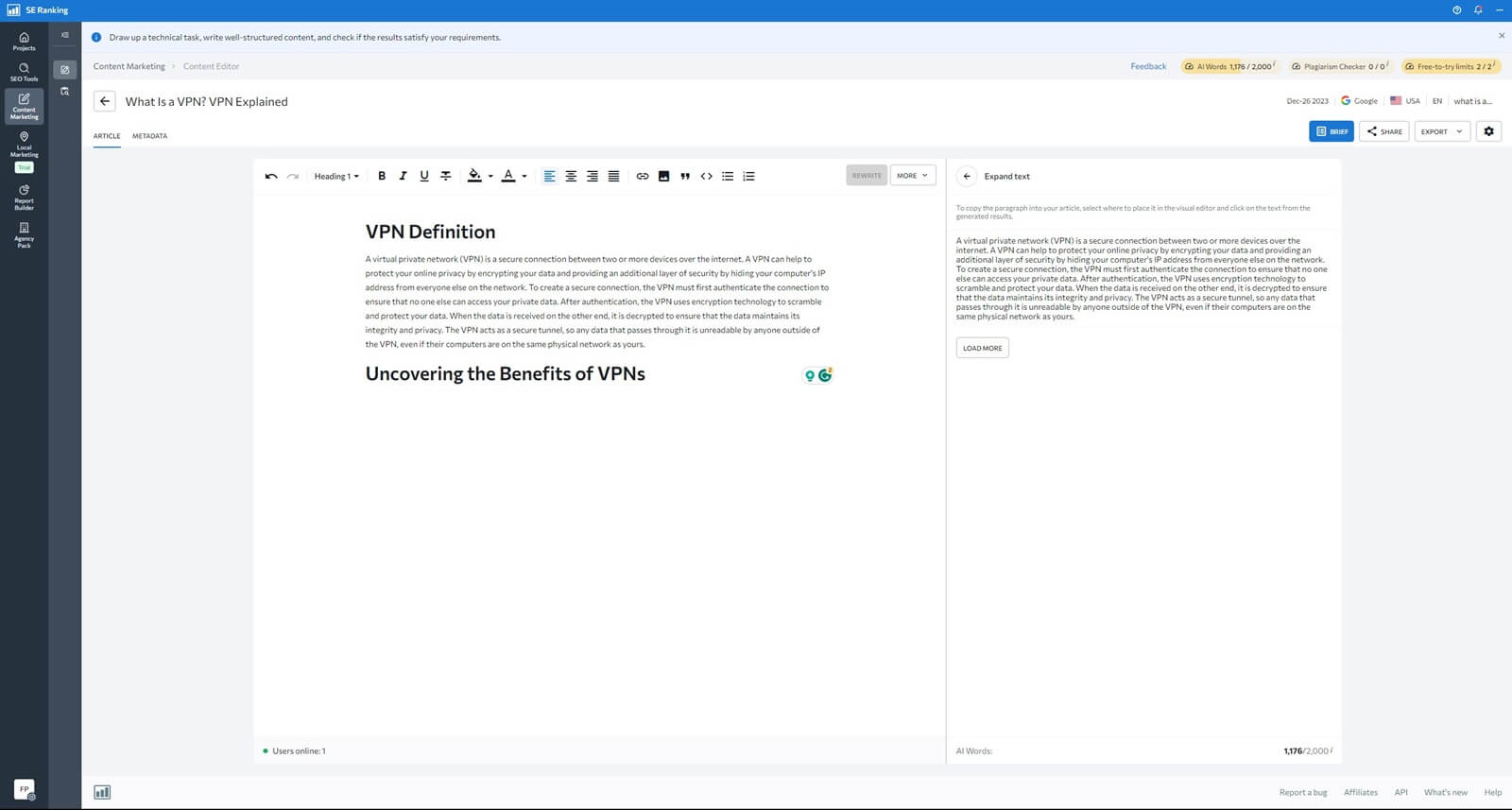
SE Ranking’s Content Editor is a paid addition. It can write from 15 to 120 articles, 25K to 250K AI words, and perform 3 to 10 monthly plagiarism checks. Either way, Content Editor is a great tool that works perfectly in multiple languages.
You can use it to create enticing headlines, subheadings, and text in between. Its plagiarism checks are surprisingly in-depth and will aid in the creation of unique content that undoubtedly ranks better. Besides, with 25K AI words in the cheapest plan, it’s excellent.
The Content Editor tool starts at only $23.2 a month on top of your subscription, while the most expensive option is $79.2 a month. It’s a shame that in our SE Ranking vs Moz duel, the latter couldn’t offer anything remotely similar.
Other Features
Apart from a few free SEO tools we’ll discuss later, Moz offers nothing exciting on top of its complete SEO suite. SE Ranking, however, has a few of them. There’s the Local Marketing pack, which helps boost your local SEO.
It includes features like local rankings, local marketing audits, and business listings. It’s great for keeping your local business flourishing and ensuring a strong online presence. This is a paid addition and SE Ranking charges you per location.
One location is $5.6 a month but if you need 50 of them, you’ll pay $144.8 instead. SE Ranking includes customizable reports where you can set up a bespoke template and manually alter the report to suit your needs.
Looker Studio integration is in the Pro and Business plans, and the service includes the Agency Pack. This one is opulent at $600 annually and is available for the aforementioned plans. We just mourn the lack of the App Center we saw in Semrush, which could extend SE Ranking’s possibilities further.
SE Ranking vs Moz: Ease of Use
Ease of use is one of SE Ranking’s best features. From the screenshots above, you can see how beautiful it is. In some instances, we like it more than Semrush, as it provides clear data that you can easily notice and grasp. The interface is modern and minimalistic.
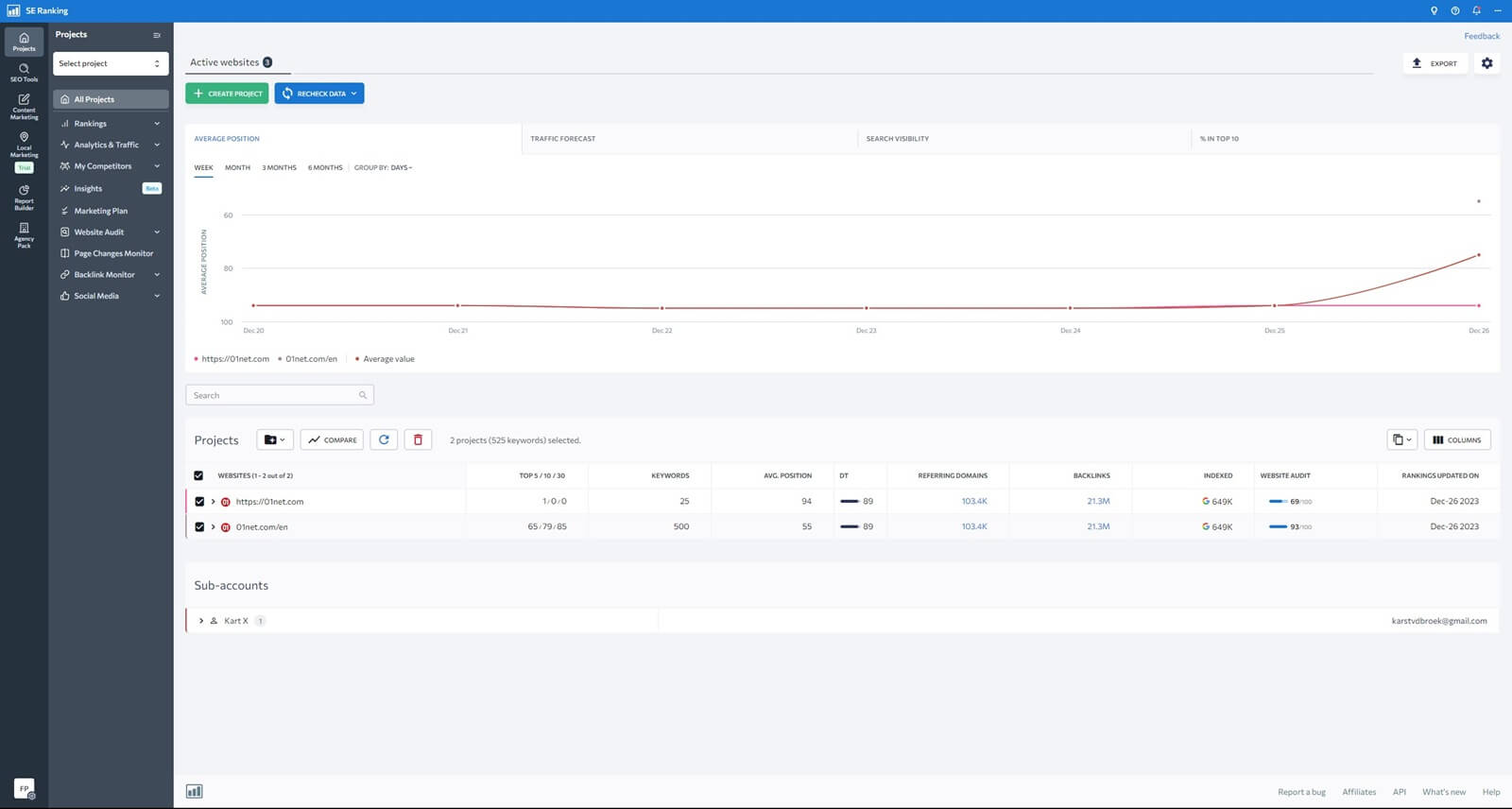
The left-hand side is for various SEO tools, while the majority of the screen is taken by graphs, statistics, and very few walls of text. SE Ranking works well on mobile devices and its app is okay given its limitations dictated by the small screen.
Moz looks “okay” but it’s more focused on tables and text, rather than graphs. In fact, its graphs look dated and the experience isn’t the most visually appealing. Moz is indeed a tad more complicated, making some more important metrics not so pronounced.
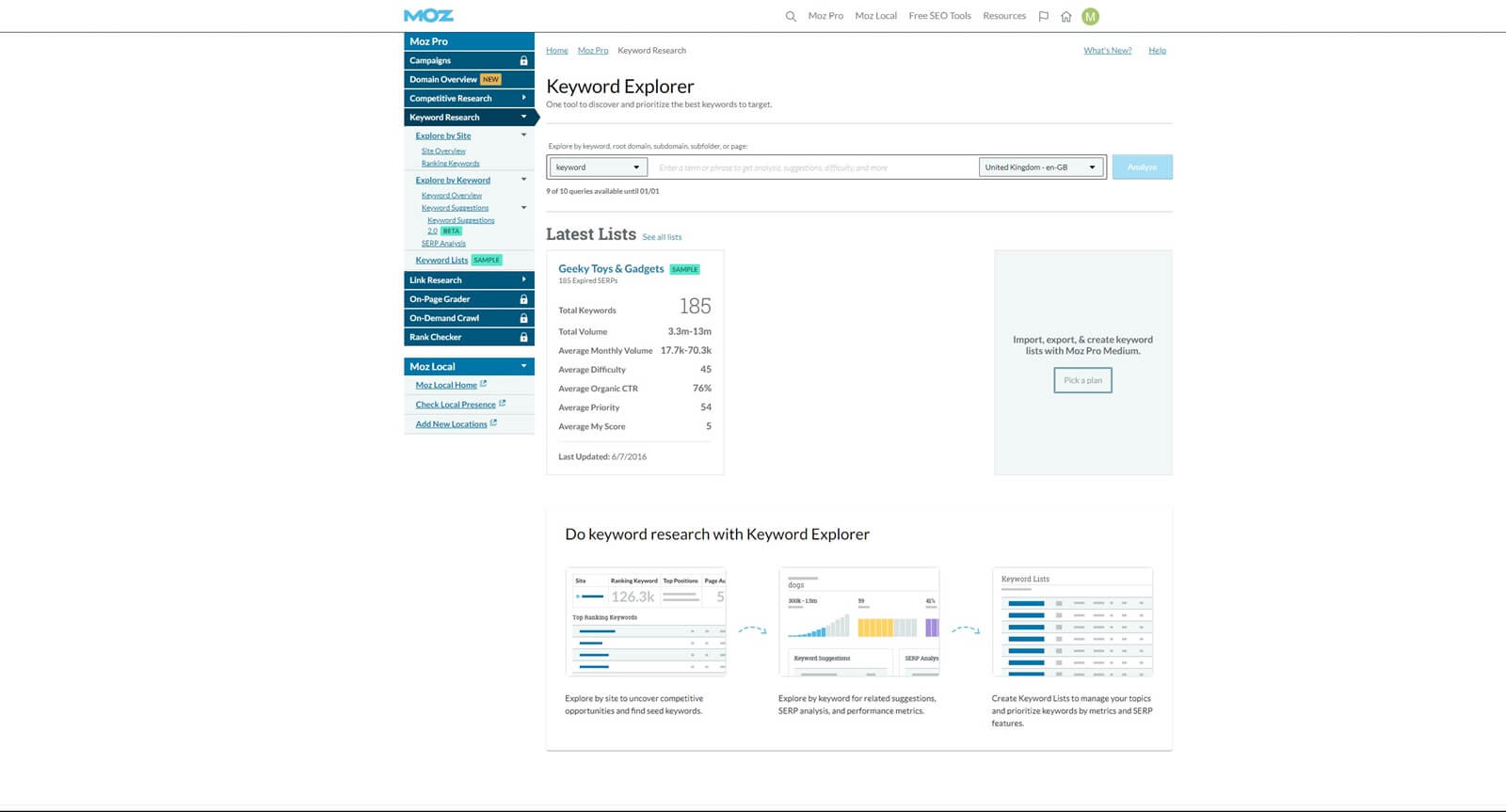
On the brighter side, Moz is snappy and quick, with no long loading times. However, we can say that about SE Ranking as well. Mobile integration is sublime – not the best – so we recommend using Moz on a bigger screen, be it a laptop, tablet, or computer.
We should also praise their crawling speeds. Both providers will crawl larger sites fairly quickly, albeit, in our test, SE Ranking was slightly faster. We’re satisfied with both but ease of use is surely on SE Ranking’s side even when judging by screenshots.
Moz vs SE Ranking Price Review
Our SE Ranking vs Moz comparison will also go over the price aspect. So, which SEO tool is cheaper, Moz or SE Ranking? Let us go through their current prices.
Moz
Moz offers monthly and annual plans, whereas the latter are cheaper. As you can see, the standard plan is $79 a month but as always, the next plan is much better. This time, it’s also way more expensive at $143 a month or over $1,700 yearly.
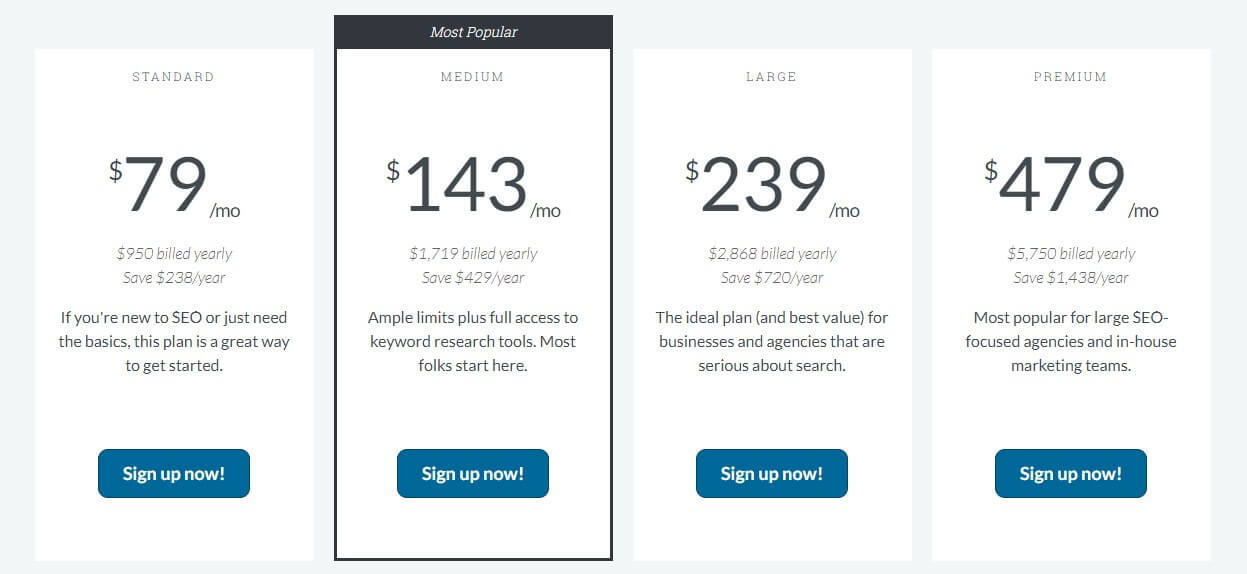
Large and Premium plans are usually for businesses and agencies, with more generous crawling limits, trackable keywords, and more user seats – up to 5. Its more expensive plans usually revolve around higher limits rather than introducing new features.
Branded reports and report templates are missing from the Standard plan but in all other plans, they’re there. Impressively, Moz includes 24/7 support for all plans and a 30-day free trial is available for all newcomers. Sadly, Moz lacks a refund policy.
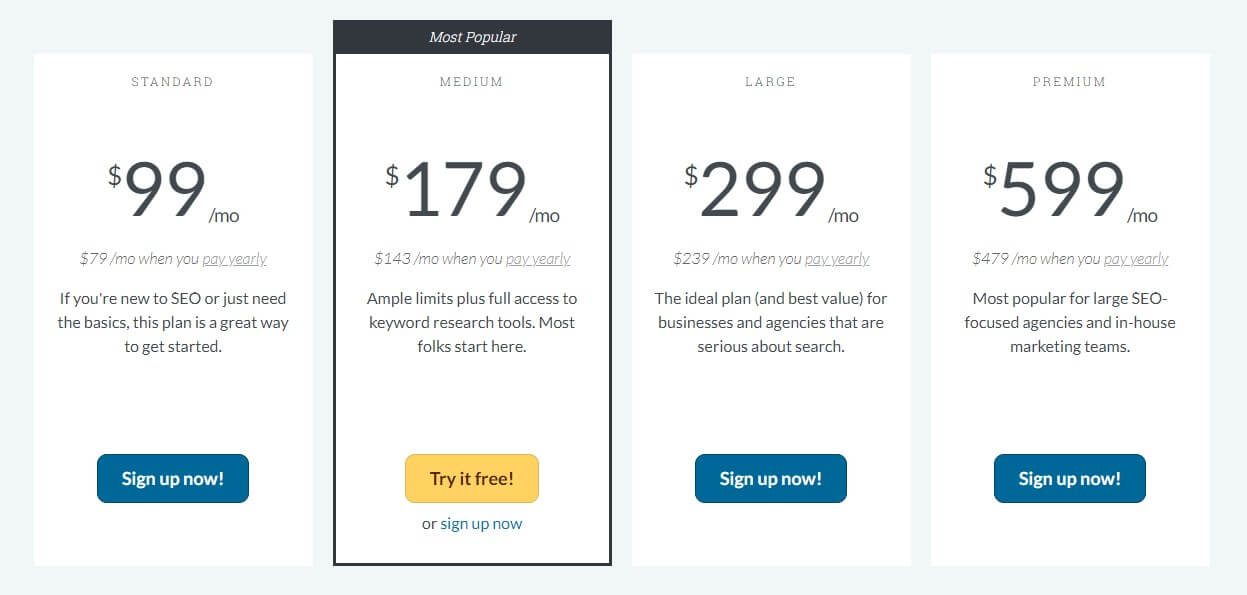
Moz’s monthly plans are displayed above and it’s easy to see their expansiveness. The Medium plan at $179 a month is a far cry from Semrush’s Pro plan at $129, which, despite being the lowest-tier Semrush’s plan, is still better.
SE Ranking
A breath of fresh air is SE Ranking because it’s so affordable compared to Moz. Yet, as you see, its offerings surpass Moz’s on more than a few occasions. Like its rival, SE Ranking comes with annual and monthly plans. Annual plans are cheaper.
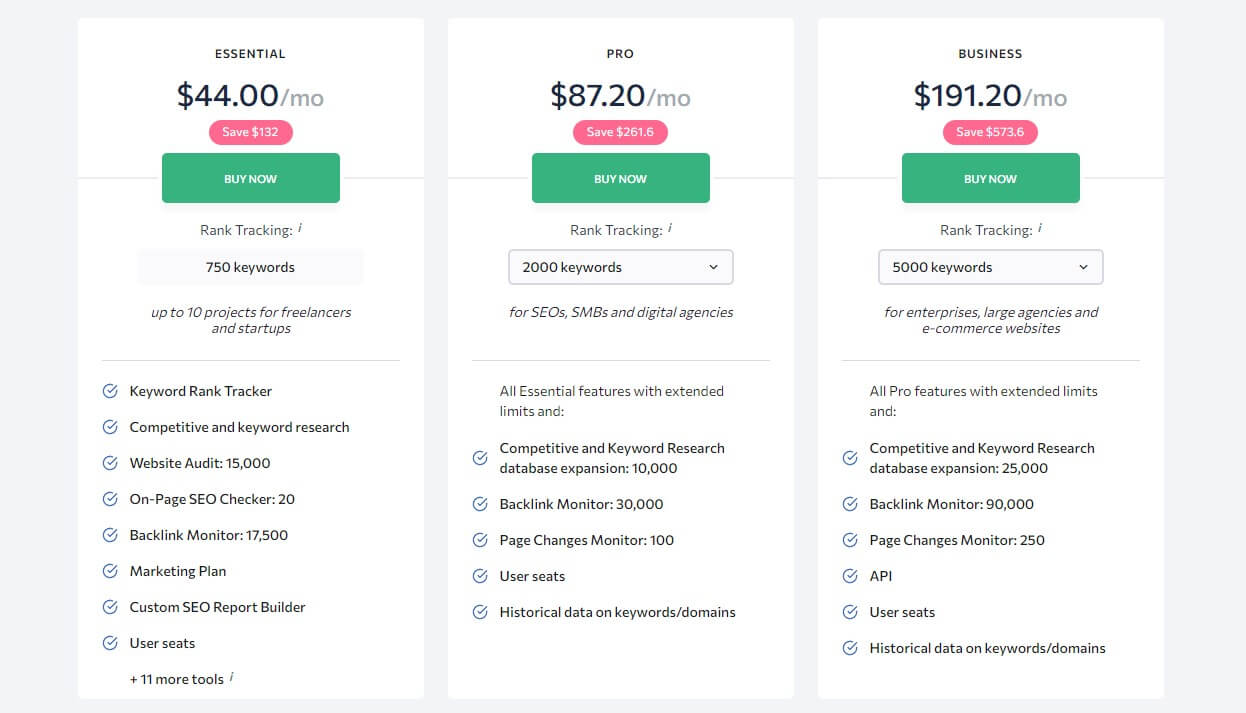
The Essential plan at $44 a month can track 750 keywords and supports up to 10 projects. A much better Pro plan at $87.2 a month can track 2,000 keywords and allows you to buy the Agency Pack. It also introduces Looker Studio integration, which the Essential plan lacks.
This plan also supports 3 user seats, whereas, the Business plan supports 5. That one costs $191.20 a month, with 5,000 keywords to track, 90,000 monitored backlinks, and full API access for additional third-party integrations.
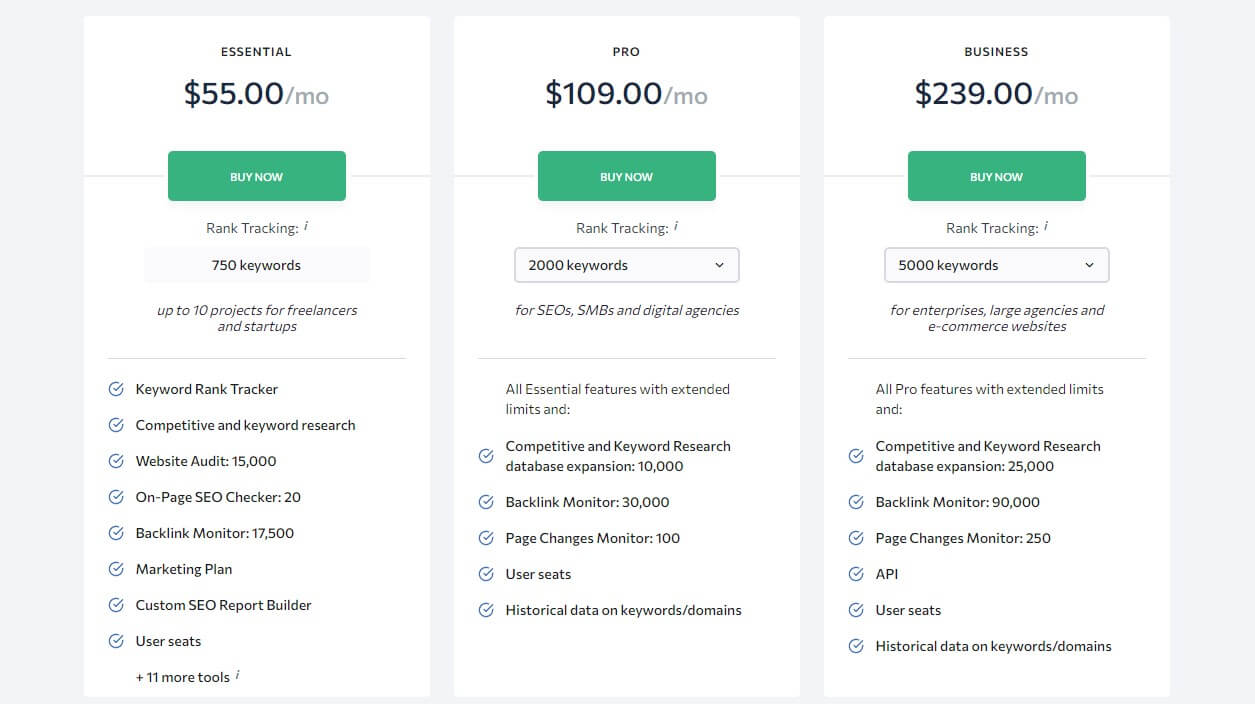
As you can see above, its monthly plans are inexpensive too. More so compared to Moz, Ahrefs, or even Semrush. SE Ranking allows for a 14-day free trial through our site for which you don’t have to provide credit card information – sweet!
Like Moz, SE Ranking has no refund policy and all purchases are definitive. Thankfully, you can try Semrush for free for 14 days as well and enjoy a 7-day refund policy if you make up your mind.
Which One Is a Better Free SEO Tool?
As a free SEO tool, SE Ranking isn’t the best. It offers an impeccable free trial but after it ends, you have to decide on a plan to enjoy all of the features we discussed in our SE Ranking vs Moz duel. Of course, some free tools are there but they’re unimpressive.
We like its SEO Proposal Template and the Website Speed Checker. Also, the “Robots.txt” Generator is here, which helps search engines index your site properly. A few more, like CMS Checker, Subdomain Folder, and Domain Age Checker are worth mentioning.
Moz, on the other hand, has plenty of them. With it, you can research keywords for free. Heck, the link explorer is also free, which allows you to analyze your backlink profile without paying a dime. Moz also comes with free domain analysis to make things better.
Additionally, there’s MozBar, a free extension for Chrome that analyzes several SEO-related aspects of each website you visit. Its Keyword Explorer tool is free as well and through it, you’ll get more than a couple of suggestions, which is pretty nifty.
Overall, Moz’s free tools are more akin to its paid tools, so it’s like Semrush. Semrush – to remind you – can be used for free but you’re limited to 10 requests per day. SE Ranking’s free trial conditions are impeccable and that’s likely the reason behind its poor free tools.
You can’t get a free trial without payment info AND a free plan. Some corners must be cut.
Customer Support of Moz and SE Ranking
We won’t lose too much time on customer support. In this SE Ranking vs Moz comparison, both offer stellar support, which, in some cases, depends on your subscription plan. Low-tier plans exclude priority support. In SE Ranking Pro and Business plans are the best.
Their priority support makes it easy to get in touch and ask for help. The Essential plan has low-priority support that still responds quickly and is here to aid you. Moz’s 24/7 support is in all plans and everything functions through the ticketing system.
SE Ranking and Moz have on-site FAQs and guides to complement everything. Moz has a community where you can get in touch with 500K+ Moz users and discuss various topics. SE Ranking has webinars in 8 languages that you can watch for free on the site.
To cut it short, we’re pretty satisfied with both.
The Final Verdict: SE Ranking Wins Against Moz
We don’t need to count the score and fatigue ourselves with mathematics to see who is the winner. SE Ranking wins today’s battle and is a better SEO tool. However, we can’t disregard Moz and say it’s underwhelming. Although, it is slightly when its price is considered.
Regardless, Moz is excellent at backlink analysis, and offers a nifty 30-day free trial, and a handful of free tools. Not to mention its intuitive rank tracking and vital keyword suggestions that can be advantageous for improving search engine ranking.
On the other hand, SE Ranking excels in ease of use, and with its modern look come more ubiquitous features. We like it more for website audits, on-page SEO fixes, local SEO, content marketing, and AI Writing capabilities that Moz lacks.
If we take its inexpensiveness into account, what’s not to like about SE Ranking? Well, maybe its anemic free tools but that’s the only complaint. Okay, so to summarize this SE Ranking vs Moz comparison for 2025, you should buy SE Ranking.